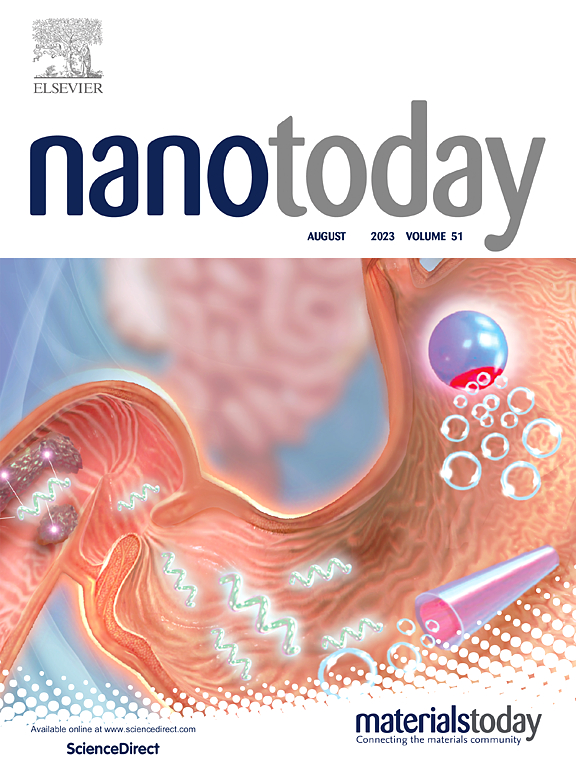磁性驱动、ph响应的Fe3O4/ZIF-8植入物涂层用于生物膜的预防和治疗
IF 10.9
1区 材料科学
Q1 CHEMISTRY, MULTIDISCIPLINARY
引用次数: 0
摘要
抗菌涂层具有预防和治疗种植体生物膜感染的能力,是一种很有前途的表面处理策略,但涂层很难根除已经形成的生物膜。磁驱动涂层可以物理破坏表面附着的生物膜,从而提高抗菌效果。然而,现有的磁性涂层不能抑制细菌的初始生长,对涂层稳定性的要求限制了其磁性可控性。本文通过在钛表面简单地混合Fe3O4和ZIF-8纳米颗粒,开发了一种磁驱动的ph响应涂层。在生理pH下,Fe3O4纳米颗粒由于电荷吸引和静电相互作用在表面稳定且无磁驱动。而在细菌生长引起的酸性pH下,ZIF-8降解明显加快,释放Zn2 +,恢复Fe3O4纳米颗粒的磁性可控性。释放的Zn2+杀死最初附着的细菌,抑制随后的生物膜形成。一旦生物膜形成,Fe3O4纳米颗粒就可以被磁性拉离,破坏生物膜结构,然后增强抗生素的杀伤作用。与裸钛盘相比,Fe3O4/ZIF-8涂层具有良好的生物相容性和成骨性。动物实验进一步证明了该涂层的体内抗菌和成骨性能。因此,本工作提出了解决种植体生物膜相关感染的新表面策略。本文章由计算机程序翻译,如有差异,请以英文原文为准。
Magnetically-drivable, pH-responsive Fe3O4/ZIF-8 coating on implant for biofilm prevention and treatment
Antimicrobial coatings with the capabilities to prevent and treat biofilm infections on implant are promising surface treatment strategies, but it is difficult to eradicate an already-formed biofilm by the coating. Magnetically-drivable coatings can physically destruct the surface-attached biofilm to enhance antimicrobial killing. However, current magnetic coatings cannot inhibit the initial bacteria growth and the demand of coating stability restricts their magnetic controllability. Herein, a magnetically-drivable, pH-responsive coating is developed by simply mixing Fe3O4 and ZIF-8 nanoparticles on titanium surface. In physiological pH, Fe3O4 nanoparticles are stable and non-magnetically drivable on surface due to charge attractions and electrostatic interactions. While in acidic pH caused by bacterial growth, ZIF-8 degradation is significantly accelerated, releasing Zn2 + and recovering the magnetic controllability of Fe3O4 nanoparticles. The released Zn2+ kills the initially-attached bacteria, inhibiting subsequent biofilm formation. Once a biofilm has formed, Fe3O4 nanoparticles can be magnetically pulled-off to destruct the biofilm structure and then enhance antibiotic killing. The Fe3O4/ZIF-8 coating shows excellent biocompatibility and osteogenesis to compare with bare Ti disc. Animal experiments further proved the in-vivo antimicrobial and osteogenic performances of the coating. Therefore, this work put forward a new surface strategy to solve biofilm-related infections on implants.
求助全文
通过发布文献求助,成功后即可免费获取论文全文。
去求助
来源期刊

Nano Today
工程技术-材料科学:综合
CiteScore
21.50
自引率
3.40%
发文量
305
审稿时长
40 days
期刊介绍:
Nano Today is a journal dedicated to publishing influential and innovative work in the field of nanoscience and technology. It covers a wide range of subject areas including biomaterials, materials chemistry, materials science, chemistry, bioengineering, biochemistry, genetics and molecular biology, engineering, and nanotechnology. The journal considers articles that inform readers about the latest research, breakthroughs, and topical issues in these fields. It provides comprehensive coverage through a mixture of peer-reviewed articles, research news, and information on key developments. Nano Today is abstracted and indexed in Science Citation Index, Ei Compendex, Embase, Scopus, and INSPEC.
 求助内容:
求助内容: 应助结果提醒方式:
应助结果提醒方式:


